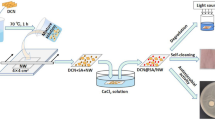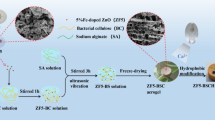Abstract
Non-biodegradable and toxic photocatalysts pose as secondary threats to the environmental security. In this work, non-toxic biocomposites were prepared using natural bamboo cellulose fibers (CF), polyvinyl alcohols (PVAs), BiVO4, and carbon dots (CDs) from biomaterials. Thereafter, their optical properties, chemical characterizations, and photocatalytic performances were evaluated. The novel BiVO4(-)CF@CDs(-)PVA composites were prepared via the combined implementation of in situ and impregnation methods. The optical properties revealed that the CDs and fibers increased the range and intensity of light absorption. The PVAs were used as the shield and dispersant to enhance stability because they have numerous chemical groups. In view of the various possible paths of electron migration, the enhanced photocatalytic activity of BiVO4(-)CF@CDs(-)PVA composites for tetracycline degradation was observed under visible light illumination. The origins of the structure, morphology, and optical mechanism in the enhancement of the photocatalytic ability of BiVO4(-)CF@CDs(-)PVA composites were discussed and demonstrated.
Similar content being viewed by others
References
Cheng D, Ngo H H, Guo W, et al. A critical review on antibiotics and hormones in swine wastewater: Water pollution problems and control approaches. J Hazard Mater, 2020, 387: 121682
Lalhriatpuia C, Tiwari D, Tiwari A, et al. Immobilized nanopillars-TiO2 in the efficient removal of micro-pollutants from aqueous solutions: Physico-chemical studies. Chem Eng J, 2015, 281: 782–792
Wang H, Li J, Zhou M, et al. Preparation and characterization of Ag2O/SWNTs photocatalysts and its photodegradation on tetracycline. J Ind Eng Chem, 2015, 30: 64–70
Kitazono Y, Ihara I, Yoshida G, et al. Selective degradation of tetracycline antibiotics present in raw milk by electrochemical method. J Hazard Mater, 2012, 243: 112–116
Yue L, Wang S, Shan G, et al. Novel MWNTs-Bi2WO6 composites with enhanced simulated solar photoactivity toward adsorbed and free tetracycline in water. Appl Catal B-Environ, 2015, 176–177: 11–19
He J, Wang M, Wu X, et al. Influence of controlled Pd nanoparticles decorated TiO2 nanowire arrays for efficient photoelectrochemical water splitting. J Alloys Compd, 2019, 785: 391–397
Polliotto V, Pomilla F R, Maurino V, et al. Different approaches for the solar photocatalytic removal of micro-contaminants from aqueous environment: Titania vs. hybrid magnetic iron oxides. Catal Today, 2019, 328: 164–171
Reddy K R, Reddy C V, Nadagouda M N, et al. Polymeric graphitic carbon nitride (g-C3N4)-based semiconducting nanostructured materials: Synthesis methods, properties and photocatalytic applications. J Environ Manage, 2019, 238: 25–40
Yang X, Xu Q. Gold-containing metal nanoparticles for catalytic hydrogen generation from liquid chemical hydrides. Chin J Catal, 2016, 37: 1594–1599
Pincella F, Isozaki K, Miki K. A visible light-driven plasmonic photocatalyst. Light Sci Appl, 2014, 3: e133
Chen F, Wu C, Wang J, et al. Highly efficient Z-scheme structured visible-light photocatalyst constructed by selective doping of Ag@AgBr and Co3O4 separately on {010} and {110} facets of BiVO4: Pre-separation channel and hole-sink effects. Appl Catal B-Environ, 2019, 250: 31–41
Yang J, Peng Y, Chen S, et al. Controllable synthesis of BiVO4 with a homojunction of (110) and (040) crystal facets for photocatalytic degradation of Rhodamine B. Mater Res Express, 2019, 6: 085501
Zhu R, Tian F, Yang R, et al. Z scheme system ZnIn2S4/RGO/BiVO4 for hydrogen generation from water splitting and simultaneous degradation of organic pollutants under visible light. Renew Energy, 2019, 139: 22–27
Cai Z, Wan Y, Becker M L, et al. Poly(propylene fumarate)-based materials: Synthesis, functionalization, properties, device fabrication and biomedical applications. Biomaterials, 2019, 208: 45–71
Ghaderi J, Hosseini S F, Keyvani N, et al. Polymer blending effects on the physicochemical and structural features of the chitosan/poly(vinyl alcohol)/fish gelatin ternary biodegradable films. Food Hydrocolloids, 2019, 95: 122–132
Levy G K, Kafri A, Ventura Y, et al. Surface stabilization treatment enhances initial cell viability and adhesion for biodegradable zinc alloys. Mater Lett, 2019, 248: 130–133
Chung J, Kwak S Y. Effect of nanoscale confinement on molecular mobility and drug release properties of cellulose acetate/sulindac nanofibers. J Appl Polym Sci, 2019, 136: 47863
Liu K, Catchmark J M. Enhanced mechanical properties of bacterial cellulose nanocomposites produced by co-culturing Gluconacetobacter hansenii and Escherichia coli under static conditions. Carbohyd Polyms, 2019, 219: 12–20
Yin C, Zhang J, Chang L, et al. Regioselectively substituted cellulose mixed esters synthesized by two-steps route to understand chiral recognition mechanism and fabricate high-performance chiral stationary phases. Anal Chim Acta, 2019, 1073: 90–98
Du M, Du Y, Feng Y, et al. Facile preparation of BiOBr/cellulose composites by in situ synthesis and its enhanced photocatalytic activity under visible-light. Carbohyd Polyms, 2018, 195: 393–400
Farshchi E, Pirsa S, Roufegarinejad L, et al. Photocatalytic/biodegradable lm based on carboxymethyl cellulose, modified by gelatin and TiO2-Ag nanoparticles. Carbohyd Polyms, 2019, 216: 189–196
Li Y, Lu H, Wang Y, et al. Deposition of Au nanoparticles on PDA-functionalized PVA beads as a recyclable catalyst for degradation of organic pollutants with NaBH4 in aqueous solution. J Alloys Compd, 2019, 793: 115–126
Mallakpour S, Motirasoul F. Cross-linked poly(vinyl alcohol)/modified a-manganese dioxide composite as an innovative adsorbent for lead(II) ions. J Cleaner Prod, 2019, 224: 592–602
Tang Y, Lan X, Liang C, et al. Honey loaded alginate/PVA nanofibrous membrane as potential bioactive wound dressing. Carbohyd Polyms, 2019, 219: 113–120
Zhang L, Li Y, Liu Q, et al. Fabrication ofionic liquids-functionalized PVA catalytic composite membranes to enhance esterification by pervaporation. J Membr Sci, 2019, 584: 268–281
Vo T K, Park H K, Nam C W, et al. Facile synthesis and characterization of γ-AlOOH/PVA composite granules for Cr(VI) adsorption. J Ind Eng Chem, 2018, 60: 485–492
Sekar A D, Muthukumar H, Chandrasekaran N I, et al. Photocatalytic degradation of naphthalene using calcined Fe ZnO/PVA nanofibers. Chemosphere, 2018, 205: 610–617
Yun Y H, Kim E S, Shim W G, et al. Physical properties of mungbean starch/PVA bionanocomposites added nano-ZnS particles and its photocatalytic activity. J Ind Eng Chem, 2018, 68: 57–68
Bao X, Yuan Y, Chen J, et al. In vivo theranostics with near-infrared-emitting carbon dots—Highly efficient photothermal therapy based on passive targeting after intravenous administration. Light Sci Appl, 2018, 7: 91
Li X, Fang Y, Lin X, et al. MOF derived Co3O4 nanoparticles embedded in N-doped mesoporous carbon layer/MWCNT hybrids: Extraordinary bi-functional electrocatalysts for OER and ORR. J Mater Chem A, 2015, 3: 17392–17402
Lutsyk P, Arif R, Hruby J, et al. A sensing mechanism for the detection of carbon nanotubes using selective photoluminescent probes based on ionic complexes with organic dyes. Light Sci Appl, 2016, 5: e16028
Liu X, Wang T, Lu Y, et al. Constructing carbon dots and CdTe quantum dots multi-functional composites for ultrasensitive sensing and rapid degrading ciprofloxacin. Sens Actuat B-Chem, 2019, 289: 242–251
Liu X, Wang T, Wang W, et al. A tailored molecular imprinting ratiometric fluorescent sensor based on red/blue carbon dots for ultrasensitive tetracycline detection. J Ind Eng Chem, 2019, 72: 100–106
Wang T, Liu X, Ma C, et al. Bamboo prepared carbon quantum dots (CQDs) for enhancing Bi3Ti4O12 nanosheets photocatalytic activity. J Alloys Compd, 2018, 752: 106–114
Liu W, Li Y, Liu F, et al. Visible-light-driven photocatalytic degradation of diclofenac by carbon quantum dots modified porous g-C3N4: Mechanisms, degradation pathway and DFT calculation. Water Res, 2019, 151: 8–19
Shi R, Li Z, Yu H, et al. Effect of nitrogen doping level on the performance of N-doped carbon quantum Dot/TiO2 composites for photocatalytic hydrogen evolution. Chemsuschem, 2017, 10: 4650–4656
Wang T, Liu X, Han D, et al. In-situ synthesis of BiVO4QDs/cellulose fibers composite for photocatalytic application. Int J Hydrogen Energy, 2019, 44: 31969–31978
Montiel M, Jiménez V, Guevara E. Ultraestructura del bambú Guadua amplexifolia (Poaceaea: Bambusoideae) presente en Costa Rica. Rev Biol Trop, 2006, 54: 21–28
Yang X, Jing M, Shen X, et al. Microwave absorption of sandwich structure based on nanocrystalline SrFe12O19, Ni0.5Zn0.5Fe2O4 and α-Fe hollow microfibers. J Nanosci Nanotech, 2014, 14: 2419–2424
Ma X C, Dai Y, Yu L, et al. Energy transfer in plasmonic photocatalytic composites. Light Sci Appl, 2016, 5: e16017
Reier T, Oezaslan M, Strasser P. Electrocatalytic oxygen evolution reaction (OER) on Ru, Ir, and Pt catalysts: A comparative study of nanoparticles and bulk materials. ACS Catal, 2012, 2: 1765–1772
Yang X C, Liu R J, Shen X Q, et al. Enhancement of microwave absorption of nanocomposite BaFe12O19/α-Fe microfibers. Chin Phys B, 2013, 22: 058101
Işik C, Arabaci G, Ispirli Doǧaç Y, et al. Synthesis and characterization of electrospun PVA/Zn2+ metal composite nanofibers for lipase immobilization with effective thermal, pH stabilities and reusability. Mater Sci Eng-C, 2019, 99: 1226–1235
Noh Y K, Da Costa ADS, Park Y S, et al. Fabrication of bacterial cellulose-collagen composite scaffolds and their osteogenic effect on human mesenchymal stem cells. Carbohyd Polyms, 2019, 219: 210–218
Wu X, Xie Y, Xue C, et al. Preparation of PVA-GO composite hydrogel and effect of ionic coordination on its properties. Mater Res Express, 2019, 6: 075306
Pereira V A, de Arruda I N Q, Stefani R. Active chitosan/PVA films with anthocyanins from Brassica oleraceae (Red Cabbage) as time-temperature indicators for application in intelligent food packaging. Food Hydrocolloid, 2015, 43: 180–188
Yu Z, Li B, Chu J, et al. Silica in situ enhanced PVA/chitosan biodegradable films for food packages. Carbohyd Polyms, 2018, 184: 214–220
Bai S, Chu H, Xiang X, et al. Fabricating of Fe2O3/BiVO4 heterojunction based photoanode modified with NiFe-LDH nanosheets for efficient solar water splitting. Chem Eng J, 2018, 350: 148–156
Zhang Z, Jiang X, Mei J, et al. Improved photoelectrocatalytic hydrogen generation through BiVO4 quantum-dots loaded on nanostructured SnO2 and modified with carbon quantum-dots. Chem Eng J, 2018, 331: 48–53
Kim C, Cho K M, Al-Saggaf A, et al. Z-scheme photocatalytic CO2 conversion on three-dimensional BiVO4/carbon-coated Cu2O nano-wire arrays under visible light. ACS Catal, 2018, 8: 4170–4177
Xu T, Hu J, Yang Y, et al. Ternary system of ZnO nanorods/reduced graphene oxide/CuInS2 quantum dots for enhanced photocatalytic performance. J Alloys Compd, 2018, 734: 196–203
Sui Y, Wu L, Zhong S, et al. Carbon quantum dots/TiO2 nanosheets with dominant (001) facets for enhanced photocatalytic hydrogen evolution. Appl Surf Sci, 2019, 480: 810–816
Zhou Y, Zahran E M, Quiroga B A, et al. Size-dependent photocatalytic activity of carbon dots with surface-state determined photoluminescence. Appl Catal B-Environ, 2019, 248: 157–166
Moztahida M, Nawaz M, Kim J, et al. Reduced graphene oxide-loaded-magnetite: A Fenton-like heterogeneous catalyst for photocatalytic degradation of 2-methylisoborneol. Chem Eng J, 2019, 370: 855–865
Saini P K, Kumar N, Chandra R, et al. Facile synthesis of novel SWCNT/HgS nanohybrid: An effective photocatalyst for degradation of methylene blue. Mater Lett, 2019, 250: 5–8
Tun P P, Wang J, Khaing T T, et al. Fabrication of functionalized plasmonic Ag loaded Bi2O3/montmorillonite nanocomposites for efficient photocatalytic removal of antibiotics and organic dyes. J Alloys Compd, 2020, 818: 152836
Li X, Cui K, Guo Z, et al. Heterogeneous Fenton-like degradation of tetracyclines using porous magnetic chitosan microspheres as an efficient catalyst compared with two preparation methods. Chem Eng J, 2020, 379: 122324
Xu Y, You Y, Huang H, et al. Bi4NbO8Cl {001} nanosheets coupled with g-C3N4 as 2D/2D heterojunction for photocatalytic degradation and CO2 reduction. J Hazard Mater, 2020, 381: 121159
Author information
Authors and Affiliations
Corresponding authors
Additional information
This work was supported by the National Natural Science Foundation of China (Grant No. 21908080) and Natural Science Foundation of Jiangsu Province (Grant No. Bk20180884). We would like to thank Editage (www.editage.cn) for English language editing.
Supporting Information
The supporting information is available online at http://tech.scichina.com and https://link.springer.com. The supporting materials are published as submitted, without typesetting or editing. The responsibility for scientific accuracy and content remains entirely with the authors.
Supporting information
11431_2020_1611_MOESM1_ESM.docx
In-situ construction of BiVO4(-)Cellulose fibers@CDs(-)Polyvinyl alcohol composites for the photocatalytic degradation of tetracycline
Rights and permissions
About this article
Cite this article
Wang, T., Liu, X., Ma, C. et al. In situ construction of BiVO4(-)cellulose fibers@CDs(-)polyvinyl alcohol composites for tetracycline photocatalytic degradation. Sci. China Technol. Sci. 64, 548–558 (2021). https://doi.org/10.1007/s11431-020-1611-y
Received:
Accepted:
Published:
Issue Date:
DOI: https://doi.org/10.1007/s11431-020-1611-y




